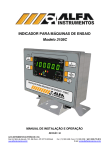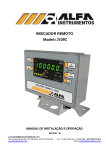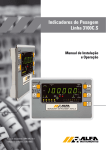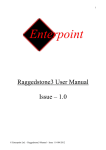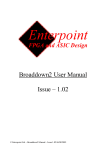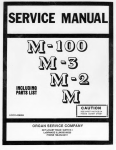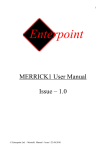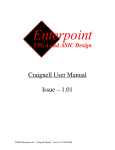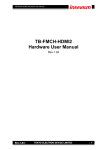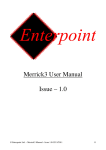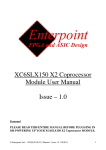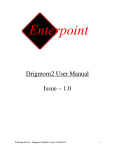Download Broaddown4 User Manual Issue – 2.00 draft
Transcript
Broaddown4 User Manual Issue – 2.00 draft © Enterpoint Ltd. - Broaddown4 Manual – Issue 2.00 11/04/2007 Kit Contents You should receive the following items with you Broaddown4 development kit: 1 - Broaddown4 Board 2 - Programming Cable Prog2 Figure 1 - Broaddown4 Board Figure 2 - Prog2 Programming Cable © Enterpoint Ltd. - Broaddown4 Manual – Issue 2.00 11/04/2007 Foreword PLEASE READ ALL OF THIS MANUAL BEFORE PLUGGING IN OR POWERING UP YOUR BROADDOWN4. PLEASE TAKE SPECIAL NOTE OF THE WARNINGS WITHIN THE MANUAL. Trademarks Virtex-4, Spartan-3, ISE, EDK, Xilinx are the registered trademarks of Xilinx Inc, San Jose, California, US. Moel-Bryn, Broaddown4 are trademarks of Enterpoint Ltd. © Enterpoint Ltd. - Broaddown4 Manual – Issue 2.00 11/04/2007 Introduction Welcome to your Broaddown4 the “Ultimate Virtex-4 Development Board”. Broaddown4 is a member of Enterpoint’s Moel-Bryn product range and offers a highly flexible approach to prototyping FPGA and System designs. The aim of this manual is to assist in using the main features of Broaddown4. There are features such as regulator shutdown control and advanced programming features that are beyond the scope of this edition of the manual. Should you have a need to use these features then please contact the support email [email protected] for detailed instructions to use these advanced features. Broaddown4 has 2 positions for Virtex-4 devices and the capability to take 2 more FPGAs with Swinyard1, Swinyard2 or future modules fitted to the Moel-Bryn expansion sockets. Each Virtex-4 position can support a choice of 6 device sizes, in 3 speed grades, and in industrial and commercial temperature speed grades giving a massive range of device combinations. An on-board Spartan-3 FPGA is also available to handle programming structures, power management functions, and CFCARD/SDCARD access. A wide range of modules are available for Broaddown4 including: Swinyard1 - Single Virtex-4 LX40-160 or SX55 with DDR2 DRAM, Swinyard2 - Single Virtex-5 LX55-110 (coming soon), Ethernet 10/100 Module, Ethernet 10/100/1000 Module (coming soon), A/D Converter Module, Dot Matrix LED Display, RS232 Module, RS485 Module, PS2 Module, USB I/F Module, SODIMM Expansion Header - SODIMM used as I/O We can also offer custom variants of Broaddown4 or modules should you require a function not covered by our current product range. Contact board sales on [email protected] for your exact requirements. © Enterpoint Ltd. - Broaddown4 Manual – Issue 2.00 11/04/2007 Block Diagram The following block diagram shows the main interconnects available on Broaddown4. Individual interfaces are described in more detail elsewhere in this manual. Figure 1 - Simplified Broaddown4 Block Diagram © Enterpoint Ltd. - Broaddown4 Manual – Issue 2.00 11/04/2007 Feature Finder - Finding Your Way Around Figure 2 - Front Side of Broaddown4 Figure 3 - Back Side of Broaddown4 Features (1) (2) (3) (4) (5) (6) XC9572XL CPLD OSCILLATOR JTAG HEADER LHS DIL HEADER PLATFORM FLASH (SPARTAN-3) JTAG HEADER © Enterpoint Ltd. - Broaddown4 Manual – Issue 2.00 11/04/2007 (7) (8) (9) (10) (11) (12) (13) (14) (15) (16) (17) (18) (19) (20) (21) (22) (23) (24) (25) (26) (27) (28) (29) (30) (31) (32) (33) (34) (35) (36) (37) (38) (39) (40) (41) (42) (43) (44) (45) (46) VIRTEX-4 FPGA (DEVICE1) TPS70402 REGULATOR (CPLD + SPARTAN-3) PLATFORM FLASH (VIRTEX-4 – DEVICE1) JTAG HEADER CFCARD SOCKET SPARTAN-3 FPGA (SERVICES FPGA) OSCILLATOR PLATFORM FLASH (DEVICE2) JTAG HEADER LT4600 10A REGULATOR (1.2V) POWER MONITORING LT4600 10A REGULATOR (1.8V) POWER INPUT SOCKET1 (5V, 12V) LT4600 10A REGULATOR (2.5V) LT4600 10A REGULATOR (3.3V) POWER INPUT SOCKET2 (5V, 12V) RHS DIL HEADER OSCILLATOR VIRTEX-4 FPGA (DEVICE2) DDR2 SDRAM BANKx DEVICE2 DDR2 SDRAM BANKx DEVICE2 ICS8442 100-700MHZ CLOCK GENERATOR CLOCK BUFFER DEVICE2 I/O BANK VOLTAGE SELECTOR DEVICE1 I/O BANK VOLTAGE SELECTOR CLOCK BUFFER LM86 THERMAL DIODE MEASUREMENT I.C. DDR2 SDRAM BANKx DEVICE1 NXP PA1101A PCI-E PHY X1 PCI-E CONNECTOR LM4600 10A REGULATOR (1.2V or 1.0V to MOEL-BRYN) EDGE CONNECTOR MOEL-BRYN SOCKET2 DDR2 SODIMM SOCKET DEVICE2 MOEL-BRYN SOCKET USER REGULATOR1 SDCARD/MMC CARD SOCKET MOEL-BRYN SOCKET USER REGULATOR2 DDR2 SODIMM SOCKET DEVICE1 MOEL-BRYN SOCKET1 ENCRYPTION KEY BATTERY HOLDER © Enterpoint Ltd. - Broaddown4 Manual – Issue 2.00 11/04/2007 Getting Started (1) Please read the whole of this manual before starting with your board. (2) Connect the Broaddown4 to a computer power supply (un-powered) using the disk drive type power cables that are in most personal computers. The Broaddown4 can be operated either in X1 PCI-E slot, or stand alone on the bench, but does need both a 5V and 12V to be connected for full operation. The PCI-E connector will not supply sufficient power for Broaddown4 to operate and the disk drive power input must always be used even when fitted with a PC. (3) Switch on your power source. © Enterpoint Ltd. - Broaddown4 Manual – Issue 2.00 11/04/2007 Device1 Virtex-4 FPGA Device1 has the following clock connections, CLOCK CONNECTION Cypress CLKA Cypress CLKB Cypress CLKC Cypress CLKX Cypress PECAL PLL PLL feedback in PLL feedback out DEVICE1 PIN (p) AG17 AH17 AH18 AG18 AF16 E16 F18 K19 DEVICE1 PIN (n) ~ ~ ~ ~ AG16 F16 G18 J19 FPGA Device1 (7) is one of Xilinx Virtex-4 FPGAs LX40, LX60, LX80, LX100, LX160 or SX55. These devices are available in speed grades -10, -11, -12 and in both commercial and industrial temperature grades. Enterpoint's flexible manufacturing system allows a build to order options such that you can specify size, speed grade and temperatures options of the device that we fit in this socket. FPGA Device1 has interfaces to PCI-E (35/36), SODIMM1 (44), LHS DIL Header (4), EDGE Connector (38), Moel-Bryn Socket1 (45), Device2 (25), Device3 (12) and DDR2 Bank1 (34). It is supported by clock circuits (28/32) capable of being programmed to deliver clocks up to 700 MHz . I/O banks 8, 9, 10, 11, 12 and 14 of Device1 can individually be jumper selected to voltages of 1.2V, 1.8V, 2.5V or 3.3V using the bank voltage selector (31). DCI impedance matching features are available on Banks 1, 2, 5, 6, 7, 8, 9, 10, 11, 12, 13 and 14 of Device1. Each VRN and VRP signal of these banks has 100R resistors wired appropriately. The PCI-E interface is based on a NXP(Philips) Semiconductors PXA1101A Phy (35) and delivers a X1 PCI-E interface. At the normal clocking rate of 2.5GHz this interface can transfer at up to 2 GBits/s of data which is a significant increase over conventional PCI interfaces. The PCI-E interface, unlike conventional PCI, does not share the bus to/from the PCI-E slot and the loss of bandwidth typically seen in conventional PCI is less prevalent. Structures of the PCI-E implemented in the host personnel computer may restrict the bandwidth of the PCI-E. Discussion of these restrictions is beyond the topic of this manual. The PCI-E logic IP is not included with Broaddown4. A number of providers exist for this IP. SODIMM1 (44) supports a DDR2 module of up to 2 Gbyte’s in a X64 data configuration. This memory socket is capable of running up to TBA MHz and can deliver a memory bandwidth up to TBA GByte/s. If not used for a memory function our optional SODIMM I/O Expansion Module allows the use of the Device1 connections to this socket as general I/O. Enterpoint can also provide custom modules including microprocessors or other functions in the SODIMM format. The LHS DIL Header (4) provides a simplistic expansion capability. Enterpoint provides a range of modules for this socket including RS232, RS485, ADV7202, IDE, ADC, CODEC, and Displays. Up to 102 I/O are available on this header for use with modules. The header also provides power at 3.3V, 2.5V and optionally 1.8V or 1.2V. © Enterpoint Ltd. - Broaddown4 Manual – Issue 2.00 11/04/2007 The EDGE Connector (38) provides 48 3V3 capable IO’s there is also GND, 3V3 and 2V5 power pick up points with the POWER at the top pin1 and GND spread throughout the connector. When Device2 (25) is fitted 76 connections to/from Device1 can support up to 38 GBit/s of data transfer between the 2 FPGAs. The interface supports source synchronous interfaces including compensative clock looping on the interface to correct for board level delays. The clocking structure of Broaddown4 also support matched clocking structures to both Device1 and Device2 allowing a simpler hook up between the devices albeit at lower data rates. CAUTION PLEASE MAKE SURE THE BANK VCCIO’s ARE MATCHED BEFORE POWERING UP BROADDOWN4 Device3 (12) interface offers access to CFCARD, SDCARD facilities. It also can support the programming of Device 2, The Platform Flash, and both Moel-Bryn sockets. To support these facilities suitable designs must be implemented within Device1 and Device3 to support these advanced features. Access to voltage and current monitoring capabilities is also possible through this interface. DDR2 Bank1 (34) – A single X16 DDR2 device is supported on this interface. This interface is capable of running at TBA MHz offering up to TBA GByte/s data transfer. Programming of Device1 can be from Platform Flash devices U12 and U13 or by JTAG cable socket J13. The JTAG socket takes a Xilinx standard 14 pin, 2mm, ribbon cable connection. Alternatively programming can be handled by Device3 which can be loaded with designs to support programming data routed through Device1 – either from PCI-E interface, a source on Moel-Bryn Socket1, a source on the LHS DIL Headers or from some algorithmic function contained in Device1. Device3 can also support programming of data from either CFCARD or SDCARD sockets either from memory cards inserted or via Ethernet, serial or other special network connections host via these sockets. Please note that reprogramming Device1 may disrupt the function of the PCI-E interface unless special measures are taken to either store the PCI-E configuration data and to restore after reconfiguration or to cause a host system reboot. Enterpoint does not supply IP for the enhanced Device3 programming features with the Broaddown4 but suitable designs can be supplied to your specification at a charge. Contact board sales [email protected] for a quote and timescale for your specific needs. © Enterpoint Ltd. - Broaddown4 Manual – Issue 2.00 11/04/2007 Device2 Device2 has the following clock connections, CLOCK CONNECTION Cypress CLKA Cypress CLKB Cypress CLKC Cypress CLKX Cypress PECAL PLL PLL feedback in PLL feedback out DEVICE2 PIN (p) AJ17 AH17 AF18 AG18 AK18 E18 G17 F18 DEVICE2 PIN (n) ~ ~ ~ ~ AK17 E17 G16 G18 The Device2 position of Broaddown4 supports one of Xilinx Virtex-4 FPGAs LX40, LX60, LX80, LX100, LX160 or SX55. These devices are available in speed grades -10, -11, -12 and in both commercial and industrial temperature grades. Enterpoint's flexible manufacturing system allows a build to order options such that you can specify size, speed grade and temperatures options of the device that we fit in this socket. Device2 has interfaces to SODIMM2, RHS DIL Header, Moel-Bryn Socket2, Device1, Device3, DDR2 Bank2, and DDR2 Bank3. It is supported by clock circuits capable of being programmed to deliver clocks up to 700 MHz . I/O banks 8, 9, 10, 11, 12 and 14 of Device1 can individually be jumper selected to voltages of 1.2V, 1.8V, 2.5V or 3.3V. DCI impedance matching features are available on Banks 1, 2, 5, 6, 7, 8, 9, 10, 11, 12, 13 and 14 of Device1. Each VRN and VRP signal, of these banks, has 100R resistors wired appropriately. SODIMM2 supports a DDR2 module of up to 2 GByte in a X64 data configuration. This memory socket is capable of running up to TBA MHz and can deliver a memory bandwidth up to TBA GByte/s. If not used for a memory function our optional SODIMM I/O Expansion Module allows the use of the Device1 connections to this socket as general I/O. Enterpoint can also provide custom modules including microprocessors or other functions in the SODIMM format. The RHS DIL Header provides a simplistic expansion capability. Enterpoint provides a range of modules for this socket including RS232, RS485, ADV7202, IDE, ADC, CODEC, and Displays. Up to 68 I/O are available on this header for use with modules. The header also provides power at 3.3V. Extra I/Os are available in this header when larger devices are fitted in the Device2 position. The PIN Grid array allows a greater expansion of the RHS DIL header providing an extra 78 IO’s but also extra power support by providing extra GND pins but also 2V5, 1V8 and 1V2, it is Enterpoint’s intention that this slot can support another FPGA or microprocessor module for more dedicated purposes. 76 connections to/from Device1 can support up to 38 GBit/s of data transfer between the 2 FPGAs. The interface supports source synchronous interfaces including compensative clock looping on the interface to correct for board level delays. The clocking structure of Broaddown4 also support © Enterpoint Ltd. - Broaddown4 Manual – Issue 2.00 11/04/2007 matched clocking structures to both Device1 and Device2 allowing a simpler hook up between the devices albeit at lower data rates. The Device3 interface offers access to CFCARD, SDCARD facilities. It also can support the programming of Device 1, The Platform Flash, and both Moel-Bryn sockets. To support these facilities suitable designs must be implemented within Device2 and Device3 to support these advanced features. Access to voltage and current monitoring capabilities is also possible through this interface. DDR2 Bank2 – A single X16 DDR2 device is supported on this interface. This interface is capable of running at TBA MHz offering up to TBA GByte/s data transfer. DDR2 Bank3 – A single X16 DDR2 device is supported on this interface. This interface is capable of running at TBA MHz offering up to TBA GByte/s data transfer. Programming of Device2 can be from Platform Flash devices U23 and U24 or by JTAG cable socket J20. The JTAG socket takes a Xilinx standard 14 pin, 2mm, ribbon cable connection. Alternatively programming can be handled by Device3 which can be loaded with designs to support programming data routed through Device1 – either from PCI-E interface, a source on Moel-Bryn Socket1, a source on the LHS DIL Headers or from some algorithmic function contained in Device1. Device3 can also support programming of data from either CFCARD or SDCARD sockets either from memory cards inserted or via Ethernet, serial or other special network connections host via these sockets. Enterpoint does not supply IP for the enhanced Device3 programming features with the Broaddown4 but suitable designs can be supplied to your specification at a charge. Contact board sales [email protected] for a quote and timescale for your specific needs. © Enterpoint Ltd. - Broaddown4 Manual – Issue 2.00 11/04/2007 Device3 Device3 has a dedicated clock which is routed to the device this is notionally 50MHz. CLOCK SOURCE S3_CLOCK SPARTAN PIN AB12 Device3 (12) is a Xilinx Spartan-3 XC3S1000/1500 FPGA. This device provides a wide range of services to Device1 and Device2. Including CFCARD and SDCARD access, current and voltage measurement of main power rails, and programming of Device1, Device2, Moel-Bryn Socket1 and Moel-Bryn Socket2. To use these services a suitable design for Device3 must be loaded into the Platform Flash (5) supporting these features. SPARTAN JTAG SIGNALS TCK TMS TDI TDO TDO CONNECTOR TDO PROM 2 INT_B PROG_B BUSY DONE CCLK HSWAP_ENABLE READ_WRITE CS_B ENEXTSEL REV_SEL0 REV_SEL1 M0 M1 M2 D0 D1 D2 D3 D4 D5 D6 D7 TCK TMS TDI TDO INT_B DEVICE 1 E2 D1 G2 G6 P1 D2 C1 D3 F4 E1 F3 L5 L6 K2 G1 H5 F5 K3 K4 K1 F2 E3 G5 D4 C4 C3 C2 E4 MOEL BRYN SIGNALS M3 M1 M2 N4 V2 © Enterpoint Ltd. - Broaddown4 Manual – Issue 2.00 11/04/2007 DEVICE 2 E21 D22 G21 G22 J22 E20 C21 E19 K21 G19 C22 L22 L20 L21 F21 F19 F20 L18 L17 L19 K22 E22 D21 D20 F18 D19 C20 E18 Y22 Y20 Y21 W22 N19 PROG_B BUSY DONE CCLK RESET_N READ_WRITE CS_B SP1 SP2 DOUT M0 M1 M2 M3 DIN D1 D2 D3 D4 D5 D6 D7 CARD ID1 CARD ID2 CARD ID3 CARD ID4 CARD ID5 CARD ID6 CARD ID7 CARD ID8 W3 M5 M6 V1 M4 W2 Y3 N3 N2 N1 U5 W1 T4 Y1 T6 T5 U4 T1 U3 U2 T2 V3 L4 L1 V5 W4 Y2 V4 L2 L3 M21 W19 Y19 M22 V19 M20 M17 W21 V22 W20 U20 M19 U21 M18 V21 V20 T22 N21 T21 N22 U19 N20 K20 K19 G17 G18 R18 T18 U18 T17 CFCARD and SDCARD sockets can be used to host memory cards or other interfaces such as Ethernet, USB, RS232, RS485 to name a few possibilities. The data delivered can be used for programming of any of Device1, Device2, Moel-Bryn socket1 and Moel-Bryn Socket2 or can be used as general data to support embedded microprocessors or other functions needing substantial data. The Device3 pins supporting the CFCARD are as follows: FLASH MEMORY PIN A0 A1 A2 A3 A4 A5 A6 A7 A8 SPARTAN PIN AA8 W9 AA10 Y10 U7 V8 V10 U13 V13 © Enterpoint Ltd. - Broaddown4 Manual – Issue 2.00 11/04/2007 A9 A10 D0 D1 D2 D3 D4 D5 D6 D7 D8 D9 D10 D11 D12 D13 D14 D15 CD1 CD2 WP WE OE CE1 CE2 BVD1 BVD2 REG INPACT RESET WAIT VS1 VS2 CSEL REDY IORD IOWR AB13 V14 U6 W6 AA6 W18 Y17 V16 Y16 U16 Y6 W5 AA5 Y18 AA17 W16 U17 AA15 V18 AA4 Y5 U14 Y13 W17 V17 V6 V7 V9 AA9 AA11 AB10 W14 W8 U10 U12 AA13 W13 The Device3 pins supporting the MMC/SDCARD are as follows: MULTI-MEDIA CARD PIN PIN1 PIN2 PIN3 PIN4 PIN5 PIN6 PIN7 SPARTAN PIN AB18 AB15 AB14 AB11 AB9 AB8 AB5 © Enterpoint Ltd. - Broaddown4 Manual – Issue 2.00 11/04/2007 PIN8 PIN9 WRITE PROTECT1 WRITE PROTECT2 CARD DETECT1 CARD DETECT2 AB4 AA18 Y4 AA3 AB20 AA20 Device3 also hosts the serial SPI interface controlling the ADC AD7927 which measures voltage drops over a 5mΩ on the main 3.3V, 2,5V, 1.8V and 1.2V power rails of the board. It is possible to build a current profile for operation of the board and store the data on a memory card or using the sockets as a network connection remotely on a hard drive etc. ADC CHIP CS SCLK DOUT DIN SPARTAN PIN A5 A9 A11 A8 Device3 hosts the serial interface to control the 3 clock generators on board, the two dedicated cypress CY22394 parts that provide 4 clocks to each individual Virtex4. The third clock generator ICS8442 is capable of delivering 2x700MHz LVDS clock signals, these signals are fed into two ICS8745 PLL’s, which are controlled by Device3, and should allow synchronisation of both Virtex4 devices up to TBA MHz. ICS8442 PIN N0 N1 M0 M1 M2 M3 M4 M5 M6 M7 M8 PLOAD SDATA SLOAD TCLK XSEL MR VCOSEL SCLOCK ICS8745 PIN PLL_SEL SEL0 SPARTAN PIN F9 E9 C11 D11 D10 E11 F11 D9 C10 F10 E10 F12 F13 E13 E15 D14 D12 E12 C12 S3 PIN FOR DEVICE1 B12 C13 © Enterpoint Ltd. - Broaddown4 Manual – Issue 2.00 11/04/2007 S3 PIN FOR DEVICE2 E16 E17 SEL1 SEL2 SEL3 MR D13 D5 F6 B13 F17 A14 E14 F16 CY22394 PIN SHUTDOWN SUSPEND SCLK SDAT S3 PIN FOR DEVICE1 E7 D7 E6 D6 S3 PIN FOR DEVICE2 C18 D17 D18 C19 Device3 also has control of the temperature diode sensor IC, monitoring each Virtex4’s temperature diode embedded in each device with the alert signals routed to Device3 and the Alarm signal routed to the CPLD. LM86 PIN CLK DATA ALERT ALARM S3 PIN FOR DEVICE1 C5 F7 B8 CPLD 87 S3 PIN FOR DEVICE2 B17 C17 D15 CPLD 89 Device3 also has support busses that can be programmed to do any function the user wishes, there is a 20bit bus between the CPLD and Device3 the intention is that this bus would be used to route regulator control and PCIE jtag pins through to Device3, a 10bit bus between Device1 and Device2 has also been routed the intention of this bus is as a way for Device1 to control the clock generation and higher functions supported by Device3. SPARTAN VIRTEX BUS SB5 SB6 SB7 SB8 SB9 SB10 SB25 SB26 SB27 SB28 SPARTAN TO CPLD BUS 1 2 3 4 5 6 7 SPARTAN PIN G3 G4 J4 H4 N6 N5 R5 P6 H1 H2 SPARTAN PIN A4 B6 B18 A15 C6 B5 B14 © Enterpoint Ltd. - Broaddown4 Manual – Issue 2.00 11/04/2007 VITREX PIN V27 W27 U31 U30 U27 U26 U23 T23 V32 W32 CPLD PIN 16 13 18 20 14 15 25 8 9 10 11 12 13 14 15 16 17 18 19 20 B4 A12 B15 B20 A19 A13 B11 B19 A10 A18 B9 B10 C7 17 28 23 33 36 27 29 39 30 40 3 99 4 Other functions that are supported by Device3 include regulator control for the TPS70402 regulator’s onboard the enable and reset function of these devices are routed to Device3. TPS70402 USER RAIL REG1 EN1 REG1 EN2 REG2 EN1 REG2 EN2 SPARTAN PIN V12 Y12 W10 W11 © Enterpoint Ltd. - Broaddown4 Manual – Issue 2.00 11/04/2007 Broaddown4 Features Picture - power structure. Power Inputs Broaddown4 takes current from the Disk Drive Connectors (19/22) at the top right of the card. Depending on your card configuration and designs loaded into Devices1/2/3 you may need either a single feed in or a dual feed in. Each connector is each capable of carrying 5 amps of 5V input. The power supplies on the PCI-E edge connector are not used as they are inadequate to operate Broaddown4. The principal input to Broaddown4 is the 5V input. The 12V input is only used to provide a voltage for N-Channel MOSFET gate enhancement that are used in the power protection and monitoring circuits and the Moel-bryn connectors 12v rail. Main Power Regulators Broaddown4 uses 4 Linear Technology LTM4600 switching regulators to deliver current to the main 3.3V, 2.5V, 1.8V and 1.2V rails. Each of these rails is capable of supporting 10 amps in the basic configuration of Broaddown4. Further current capability may be possible by special build of Broaddown4. A further LTM4600 supports the core voltages used on the Moel-Bryn sockets and can support Swinyard1 (Virtex-4) and Swinyard2 (Virtex-5) core voltages of 1.2V and 1V respectively to a further 10 amps capability by a resistor fit change. Secondary Voltage Regulators Two TPS70402 regulators U8 and U19 provide power for the Spartan-3 FPGA, XC9572XL, power management and programming circuits. User Voltage Regulators TPS70402 regulators U46 and U47 provide 4 user settable rails that are available to use on the Moel-Bryn expansion modules. Two of these rails have 1 amp capability. The remaining two rails can support 2 amps each. Negative Voltage Regulators Regulators U26 and U39 provide -5V and -12V supplies of 100mA capability to the Moel-Bryn sockets. These supplies are not highly regulated and a linear regulator should post-regulate if high accuracy is required when these rails are used. PUSH-PULL Voltage Regulators Regulators U3 and U5 provide 1.25V and 0.9V supplies to the Moel-Bryn sockets, Sodimm sockets, Virtex4 devices as bank references and PX1101A PCIe Phillips phy. These supplies are essential in the operation of the DDR memory and Phillips phy interfaces and as such should not be tampered with to change voltage output levels. © Enterpoint Ltd. - Broaddown4 Manual – Issue 2.00 11/04/2007 Power Pickups Broaddown4 has power pickup points that can be picked up from the LHS DIL Header, RHS DIL Header, Bank Voltage Selector J17 and Bank Voltage Selector J18. Please see the relevant sections for more details on these features. Also available on Broaddown4 is two 4 pin headers that provide complete core voltage power rails enabling the possibility of Virtex5 modules to be fitted to the LHS DIL headers also available is the encryption key battery voltage please see figure 5. The voltages that are available on power pickup points on broaddown4 are as in the following table. Voltage 12V 5V 3.3V 2.5V 1.8V 1.2V CORE User1 Rail User2 Rail User3 Rail User4 Rail Header Moel-bryn Moel-bryn Moel-bryn, PIN grid array, LHS DIL header by selection and VCCIO headers J17/J18. Moel-bryn, PIN grid array, LHS DIL header by selection and VCCIO headers J17/J18. Moel-bryn, PIN grid array, LHS DIL header by selection and VCCIO headers J17/J18. Moel-bryn, PIN grid array, LHS DIL header by selection and VCCIO headers J17/J18. Moel-bryn and 4 pin headers. Moel-bryn. Moel-bryn. Moel-bryn. Moel-bryn. Note On board Virtex4 IO voltage’s 10A max On board Virtex4 IO and VCCAUX voltage’s 10A max On board Virtex4 IO and DDR voltage’s 10A max On board Virtex4 core voltage’s 10A max 10A max for Virtex4/5 support in the Moel-bryn expansion slots. 1A max 2A max 1A max 2Amax Please note secondary voltage rails on Device3’s power circuit are not available at any power pick up points. © Enterpoint Ltd. - Broaddown4 Manual – Issue 2.00 11/04/2007 Selecting FPGA Bank (Vcciox) Broaddown4 divides the variable voltage I/O pins of the fitted Virtex4’s into 6 banks for Device1 and 5 banks for Device2. The FPGA does natively support 14 banks however on Broaddown4 banks 1+5+6 on both Devices share their Vccio’s set to 1.8V for Sodimm operation. Bank 7 on Device1 and Banks 7+8 also share there Vccio’s set to 1.8V for dedicated DDR2 IC operation. Bank 13 on Device1 and Bank 14 on Device2 share there Vccio’s set to 2.5V for LVDS communication between each device. Also the Two clock banks per device are fixed to 3.3V and 2.5V. The key to voltage selection and hence supported I/O standards is headers J17 and J18. From these headers the variable IO bank voltages can individually be selected from 3.3V, 2.5V, 1.8V and 1.2V. Please note that the headers are pinned out the same way for each output power rail. The pin-out chosen makes it unlikely that input power rails can be shorted together using a single jumper. The header layouts are shown bellow. DEVICE 1 VCCIO SELECTION VD1V2 VD1V2 VD1V2 VD1V8 BANK11 VD2V5 VD2V5 BANK10 VD1V8 VD1V8 BANK14 VD2V5 VD3V3 VD3V3 VD3V3 VD3V3 VD3V3 VD3V3 VD1V8 BANK12 VD2V5 VD2V5 BANK9 VD1V8 VD1V8 BANK8 VD2V5 VD1V2 VD1V2 VD1V2 DEVICE 2 VCCIO SELECTION VD1V2 VD1V2 VD1V2 VD1V8 n.c. VD2V5 VD2V5 BANK10 VD1V8 VD1V8 BANK11 VD2V5 VD3V3 VD3V3 VD3V3 VD3V3 VD3V3 VD3V3 VD1V8 BANK12 VD2V5 VD2V5 BANK9 VD1V8 VD1V8 BANK13 VD2V5 VD1V2 VD1V2 VD1V2 CAUTION: BANKS 11, 9 of Device1 and BANKS 12, 10 of Device2 are connected together and need to be set to the same voltage. Also Note that BANK13 of Device1 and BANK14 of Device2 are connected to 2.5volts and connect to each other for devices other than LX40, LX60 and SX55 devices. © Enterpoint Ltd. - Broaddown4 Manual – Issue 2.00 11/04/2007 Programming Broaddown4 Figure 4 - JTAG Connector Positions The programming of the FPGA, CPLD and Platform Flash parts on Broaddown4 is achieved using JTAG chains. Principally it is anticipated that a JTAG cable will be used in conjunction with Xilinx ISE software although other alternatives do exist including self re-programming. There are 4 JTAG chains on Broaddown4. The first chain allows the programming of the CPLD. Normally users will not need to reprogram this device. However to use special power sequencing and/or advanced programming features reprogramming of these devices may be needed. If you are considering using these features you should study the Broaddown4 circuits and understand the full functionality before modifying the CPLD programming. The second JTAG chain allows the programming of the Spartan-3 and Platform Flash devices for the Spartan device. The Third and Forth JTAG chain allows programming of the Virtex4, Platform Flash and Moelbryn connectors also controllability can be taken over by the Spartan3 fitted onboard. However to use the advanced programming features reprogramming of the Spartan3 may be needed. If you are considering using these features you should study the Broaddown4 circuits and understand the full functionality before modifying the Spartan3 programming. Each JTAG connector has a layout is as follows: 3.3V GND TMS GND TCK GND TDO GND TDI GND The CPLD chain looks like this: Figure 5 - CPLD JTAG Chain © Enterpoint Ltd. - Broaddown4 Manual – Issue 2.00 09/04/2007 n.c. GND n.c. GND The Spartan3 FPGA JTAG chain looks like this: Figure 6 - SPARTAN FPGA JTAG Chain The Virtex4 FPGA JTAG chain looks like this in its simplest form: Figure 9 – VIRTEX FPGA JTAG Chain If a Moel-Bryn module supporting a JTAG programmable device is fitted then the jumpers J16 and J22 can be removed. Programming of the Spartan3 FPGA and Virtex4 FPGA can be achieved by direct JTAG programming or from the Platform Flash memory/s. By default the Virtex4 devices are programmed © Enterpoint Ltd. - Broaddown4 Manual – Issue 2.00 09/04/2007 from the Platform Flash memories at power up. However the default configuration mode can be altered by reprogramming the Spartan3 on Broaddown4. Direct JTAG programming is volatile and the FPGA will lose its configuration every time the board power is cycled. From sustained use of FPGA design programming the design into the Platform Flash memory is recommended. Generation of suitable Platform Flash content files and control of the JTAG chain can be achieved using the XILINX ISE tool IMPACT. © Enterpoint Ltd. - Broaddown4 Manual – Issue 2.00 09/04/2007 Primary Voltage Regulators Figure10 - Primary Power Regulator Features Broaddown4 has a power backbone based on four LM4600 integrated switching regulators. These regulators are capable of delivering 10 amps. The structure of these four regulators is a non-chain so that effectively all the current taken out of the system passes through the 5.0V rail and. Therefore the absolute maximum current that can be delivered into Broaddown4 is limited by the amount supplied to the board. The output voltages of the regulators are 3.3V, 2.5V, 1.8V and 1.2V. Practically the current delivered by the board is unlimited with the only limitation being that a max of 10 amps per rail can be delivered. On each rail a 5mΩ power resistor is in line with the supply to the board with an Op-amp circuit over it this allows measurement of individual currents on each rail including the input 5 volts via an ADC controlled by the Spartan3. This features primary objective is to act as a fault condition and power monitoring circuit enabling controlled and emergency shutdown features, by the CPLD on board each rails over and under voltage condition are monitored to allow decision making on short circuit or over current sourcing is occurring. The secondary use of this feature is as current and power profiling of designs this information can be directly passed through the PCI_E interface or stored through to the CF or SD card for reading later on in a PC. © Enterpoint Ltd. - Broaddown4 Manual – Issue 2.00 09/04/2007 Secondary Power Regulators Figure 11 - Secondary Power Regulators Broaddown4 has four secondary regulators. These regulators are derived from twin regulator devices TPS70402. These regulators will deliver 1 or 2 amps depending on which section of the TPS70402 is being used. The following voltage rails are derived using these regulators. DEVICE CURRENT RATING O/P SERIES RESISTOR Vccaux (SPARTAN3) U19 2 AMP YES Vccint (SPARTAN3) U8 1 AMP YES 3.3V (SPARTAN3 IO) U19 2 AMP YES 1.8V (NOT USED) U8 1 AMP YES VOLTAGE Current measurement can be achieved by replacing a zero resistor with a low ohm sense resistor where the above table indicates a suitable resistor position. As these regulators are variable regulators rail voltages can be modified to suit particular voltage applications if necessary. The minimum that the TPS70402 will regulate to is 1.22V. © Enterpoint Ltd. - Broaddown4 Manual – Issue 2.00 09/04/2007 Negative Rail Generation Broaddown4 has 2 inverting LT1054 charge pump regulators fitted. Each regulator will deliver about 100 mA. The regulators are operated in simple inverting mode and do not offer much in regulation in this mode. If you need tight regulation, or low noise, you should fit a post regulator to improve these parameters. The LT1054 regulators will deliver the approximate inverse of their input voltages. The inputs to these regulators are the 5.0V and 12.0V supplied from the disk drive connector and are fed directly to the Moel-Bryn connectors. Figure 12 - Negative Voltage Regulators Input Selection (J31 / J32) © Enterpoint Ltd. - Broaddown4 Manual – Issue 2.00 09/04/2007 SODIMM Socket Figure 73 - SODIMM Features WARNING – DO NOT INSERT A DDR1 SODIMM INTO THE DDR2 SODIMM SOCKET. IT WILL SHORT OUT THE POWER SUPPLIES. THE SODIMM SOCKETS ON BROADDOWN4 ARE PINNED OUT TO XILINX MIG1.5 SPECIFICATION. THE DETAILS IN THIS SECTION ARE FOR YOUR INFORMATION ONLY. Broaddown4 has two DDR2 SODIMM socket allowing the fitting of I/O expansion modules to utilise the IO if memory is not inserted. Figure 84 - SODIMM I/O Module The SODIMM I/O Module can also be used to support loopback testing of the SODIMM Socket when used in conjunction with a suitable test build loaded into the Virtex4 FPGA. The pin-out of the sodimm sockets are as follows, SODIMM1/2 DQ0 DQ1 DQ2 DQ3 DQ4 DQ5 DQ6 DQ7 DQ8 DQ9 DQ10 DQ11 DQ12 DQ13 DQ14 DQ15 DQ16 DQ17 DQ18 FPGA DEVICE 1 PIN B23 A23 A26 B26 A24 A25 G25 C23 F25 F26 D24 D25 D26 E2 F24 E24 G23 H24 A28 © Enterpoint Ltd. - Broaddown4 Manual – Issue 2.00 09/04/2007 FPGA DEVICE 2 PIN B23 A23 A26 B26 A24 A25 G25 C23 F25 F26 D24 D25 D26 E2 F24 E24 G23 H24 A28 DQ19 DQ20 DQ21 DQ22 DQ23 DQ24 DQ25 DQ26 DQ27 DQ28 DQ29 DQ30 DQ31 DQ32 DQ33 DQ34 DQ35 DQ36 DQ37 DQ38 DQ39 DQ40 DQ41 DQ42 DQ43 DQ44 DQ45 DQ46 DQ47 DQ48 DQ49 DQ50 DQ51 DQ52 DQ53 DQ54 DQ55 DQ56 DQ57 DQ58 DQ59 DQ60 DQ61 DQ62 DQ63 DQS0 DQS_N0 DQS1 A29 B25 C25 J25 K26 B22 A30 B30 K24 J24 C29 B21 A21 J20 L19 H15 G21 H20 G15 F14 F21 A15 B15 N19 N18 L15 L14 E21 D21 D12 C12 B10 C10 A11 B11 C9 G12 F10 G10 D11 D10 A8 B8 E11 F11 B27 C27 F23 © Enterpoint Ltd. - Broaddown4 Manual – Issue 2.00 09/04/2007 A29 B25 C25 J25 K26 B22 A30 B30 K24 J24 C29 B21 A21 J20 L19 H15 G21 H20 G15 F14 F21 A15 B15 N19 N18 L15 L14 E21 D21 D12 C12 B10 C10 A11 B11 C9 G12 F10 G10 D11 D10 A8 B8 E11 F11 B27 C27 F23 DQS_N1 DQS2 DQS_N2 DQS3 DQS_N3 DQS4 DQS_N4 DQS5 DQS_N5 DQS6 DQS_N6 DQS7 DQS_N7 DM0 DM1 DM2 DM3 DM4 DM5 DM6 DM7 CKE0 CKE1 CK0 CK_N0 CK1 CK_N1 A0 A1 A2 A3 A4 A5 A6 A7 A8 A9 A10 A11 A12 A13 A14 A15 BA0 BA1 BA2 RAS_N CAS_N E23 A31 B31 B28 C28 B20 A20 F13 G13 H10 H9 B13 B12 C24 D27 C22 E28 F20 J14 G11 A6 A14 A13 D30 D31 G27 G28 H22 H13 H14 M20 N20 F31 E31 B33 B32 L26 L25 F29 F28 E12 C18 C19 H12 J21 B5 J11 B7 © Enterpoint Ltd. - Broaddown4 Manual – Issue 2.00 09/04/2007 E23 A31 B31 B28 C28 B20 A20 F13 G13 H10 H9 B13 B12 C24 D27 C22 E28 F20 J14 G11 A6 A14 A13 D30 D31 G27 G28 H22 H13 H14 M20 N20 F31 E31 B33 B32 L26 L25 F29 F28 E12 C18 C19 H12 J21 B5 J11 B7 WE_N ODT0 ODT1 CS0_N CS1_N SDA SCL SA0 SA1 C7 F8 G8 A10 A9 SPARTAN B7 SPARTAN A7 SPARTAN E8 SPARTAN D8 C7 F8 G8 A10 A9 SPARTAN C16 SPARTAN D16 SPARTAN A16 SPARTAN B16 The SODIMM Socket is keyed and will only support DDR2 style SODIMM modules. DDR2 SODIMM module pin-out is incompatible with DDR1 SODIMM pin-out. Do not remove the mechanical key to allow DDR1 modules to fit. Notionally these connectors only support 1.8V and as such all-relevant bank Vccio’s are wired to 1.8V. Additionally when not used as a memory interface do not exceed the Virtex4 maximum I/O voltage for 1.8V IO signalling i.e. 2.5V as this violates the catching diode specification and damage to the FPGA will ensue. When used for a DDR2 memory function the following signal features are available: (1) 64 bit data (2) A0 TO A13 address (3) BA0 to BA2 bank address (4) DM0 to DM3 (5) CK0, CK1 (6) CKE0, CKE1 (7) RAS (8) CAS (9) CS0, CS1 Peak data rates of 200 MHz (100 MHz clock) are to be expected. SODIMM configuration prom reading is supported indirectly via the Spartan3 and can be accessed by the virtex4 FPGA via the Spartan3 Expansion Bus. This feature is not automatically enabled when Broaddown4 is delivered and you should contact support [email protected] if this feature is needed or relevant programming is required. The LP2996 regulator will provide a +/- 1.5 amp termination voltage at half the 1.8V main voltage input, this is used by the Virtex4 for termination. © Enterpoint Ltd. - Broaddown4 Manual – Issue 2.00 09/04/2007 PCI-E Interface Figure 9 - Broaddown4 PCI Interface Features An LED Just above the PCI-E interface has been added to show indication when plugged into a PCI-E slot correctly. For this interface to work as a PCI-E interface you will need to buy, or design, a suitable FPGA PCI-E logic circuit or IP core. Broaddown4 will not be supplied with any PCI-E IP core to use. A 30 day trial version of Xilinx PIPEX core can be downloaded for the Xilinx Internet website. PCI EXPRESS SIGNAL TX DATA K TX DATA 0 TX DATA 1 TX DATA 2 TX DATA 3 TX DATA 4 TX DATA 5 TX DATA 6 TX DATA 7 RX DATA K RX DATA 0 RX DATA 1 RX DATA 2 RX DATA 3 RX DATA 4 RX DATA 5 RX DATA 6 RX DATA 7 TX CLK RX CLK RX STATUS 0 RX STATUS 1 RX STATUS 2 RX IDLE RX VALID RX DET LOOPB RX POL PHY STATUS POWER DOWN 0 POWER DOWN 1 RESET_N TX COMP TX IDLE © Enterpoint Ltd. - Broaddown4 Manual – Issue 2.00 09/04/2007 DEVICE1 PIN AL18 AM20 AL20 AD21 AB16 AJ21 AB17 AG20 AH20 AK16 AM17 AM16 AL16 AM15 AF15 AG15 AL14 AL15 AL19 AP20 AG22 AH22 AJ22 AH14 AN20 AB15 AD16 AJ20 AC15 AM18 AB18 AD17 AJ15 Broaddown4 supports a X1 implementation of PCI-E. If you don’t want to use the PCI-E Edge Connector for PCI-E and run Broaddown4 standalone you can, as the Disk Drive Power Connector is the main power supply to the board. All the other Signals such as the JTAG, and SMB bus are routed to the CPLD and can be pushed onto the Spartan3 with an appropriate build programmed into the CPLD. PCI EXPRESS SIGNAL SMCLK SMDATA WAKE POWERGOOD TRST# TCK TDO TDI TMS © Enterpoint Ltd. - Broaddown4 Manual – Issue 2.00 09/04/2007 CPLD PIN 94 95 97 6 8 9 11 10 12 Right Hand Side DIL Header The RHS DIL Header provides a simple mechanical and electrical interface for add-on modules. The connectors on this header are on a 0.1 inch, 2.54 mm, pitch and allow either custom modules, stripboard or even dil style components (3.3V only) to be fitted. The RHS DIL Header supports modules and components with horizontal lead pitches of 1.6 inch pitches. The header has a permanent positive power row on the left of the right column. It also has a Gnd (0V) row to the right of left column of the header. The RHS DIL Power Rail is fixed to 3.3V, 2.5V,1.2V or 1.8V can be picked up from the pin grid array. It is advised that voltages outside 0 to 3.3V are not used unless special precautions are taken to protect Virtex4 I/Os. The Virtex4 has an absolute input voltage rating of 4.05V. The pin-out of the selection header is as follows: The Virtex4 pin-out connections are shown in the following table as is LVDS pair support. D2 PIN VOLTAGE VOLTAGE D2 PIN C34 C33 E34 D34 G33 G32 H30 H29 J30 J29 K33 K32 L31 L30 M33 M32 N30 N29 N12 AD30 AE34 AE33 AF34 AF33 AH33 AH32 AH30 AJ30 AK32 AK31 AL34 GND GND GND GND GND GND GND GND GND GND GND GND GND GND GND GND GND GND GND GND GND GND GND GND GND GND GND GND GND GND GND VD3V3 VD3V3 VD3V3 VD3V3 VD3V3 VD3V3 VD3V3 VD3V3 VD3V3 VD3V3 VD3V3 VD3V3 VD3V3 VD3V3 VD3V3 VD3V3 VD3V3 VD3V3 VD3V3 VD3V3 VD3V3 VD3V3 VD3V3 VD3V3 VD3V3 VD3V3 VD3V3 VD3V3 VD3V3 VD3V3 VD3V3 D32 C32 E33 E32 G31 G30 F34 F33 H34 H33 J32 H32 K34 J34 K29 K28 AC27 AD27 AD32 AE32 AE31 AF31 AF30 AF29 AG31 AG30 AH34 AJ34 AJ32 AJ31 AK34 © Enterpoint Ltd. - Broaddown4 Manual – Issue 2.00 09/04/2007 PIN # 1 2 3 4 5 6 7 8 9 10 11 12 13 14 15 16 17 18 19 20 21 22 23 24 25 26 27 28 29 30 31 AL33 AM33 AM32 GND GND GND VD3V3 VD3V3 VD3V3 AK33 AL31 AM31 32 33 34 The signals marked as LVDS_P and LVDS_N are routed such that the trace lengths approximately match and skew is minimised within pair. Adjacent LVDS_P and LVDS_N form the matched pair at the RHS DIL Header and the Virtex4 FPGA. For example V11 and W11 form one pair. LVDS pairs have no termination onboard and termination should be designed into any module plugged into the RHS DIL header for correct LVDS communication. When not used as LVDS signals can be used as general I/O subject to Bank Voltage Vccio’s setting and standards mixture. © Enterpoint Ltd. - Broaddown4 Manual – Issue 2.00 09/04/2007 LHS DIL Header + EDGE Connector The LHS DIL Header provides a simple mechanical and electrical interface for add-on modules. The connectors on this header are on a 0.1 inch, 2.54 mm, pitch and allow either custom modules, stripboard or even dil style components (3.3V only) to be fitted. The LHS DIL Header supports modules and components with horizontal lead pitches of 0.6 and 1.6 inch pitches. The header has a permanent positive 3.3V power row to the left of the right column followed by a permanent 2.5V and resistor selectable 1.8v or 1.2V. It also has Gnd (0V) to the right of left column of the header. It is also possible to connect any other from pin 4 down ion the 0.6 column to the Gnd (0V) Rail by means of solder bridges on the back of the Broaddown4. If any of the solder bridges are made then the user should ensure that the Virtex4 FPGA does not attempt to drive the relevant pin. Failure to do so may damage the Broaddown4. The forth Power Rail (row just bellow J10 silk screen indicator) can be selected by resistor to 1.8V or 1.2V. Alternatively other supplies can be connected to the selector by flying wire. It is advised that the native resistor R21 connecting the 1.2V is removed before attempting anything, as a short will be made. The LHS DIL Header Virtex4 pin-out connections are shown in the following table, as is LVDS pair support. D1 PIN VOLTAGE C3 C4 E2 E3 E1 D1 G5 F5 L6 K6 M1 L1 N12 N13 L3 K3 AD5 AD6 AE1 AF1 AE8 AF8 AG1 AG2 AE6 AF6 GND GND GND GND GND GND GND GND GND GND GND GND GND GND GND GND GND GND GND GND GND GND GND GND GND GND D1 PIN VOLTAGE D2 C2 F3 F4 J5 J6 H4 H5 L4 L5 K1 K2 M8 L8 P5 N5 M2 M3 AC2 AC3 AB8 AC7 AD1 AD2 AD7 AE7 VD1V2/VD1V8 VD1V2/VD1V8 VD1V2/VD1V8 VD1V2/VD1V8 VD1V2/VD1V8 VD1V2/VD1V8 VD1V2/VD1V8 VD1V2/VD1V8 VD1V2/VD1V8 VD1V2/VD1V8 VD1V2/VD1V8 VD1V2/VD1V8 VD1V2/VD1V8 VD1V2/VD1V8 VD1V2/VD1V8 VD1V2/VD1V8 VD1V2/VD1V8 VD1V2/VD1V8 VD1V2/VD1V8 VD1V2/VD1V8 VD1V2/VD1V8 VD1V2/VD1V8 VD1V2/VD1V8 VD1V2/VD1V8 VD1V2/VD1V8 VD1V2/VD1V8 VOLTAGE VOLTAGE D1 PIN VD2V5 VD2V5 VD2V5 VD2V5 VD2V5 VD2V5 VD2V5 VD2V5 VD2V5 VD2V5 VD2V5 VD2V5 VD2V5 VD2V5 VD2V5 VD2V5 VD2V5 VD2V5 VD2V5 VD2V5 VD2V5 VD2V5 VD2V5 VD2V5 VD2V5 VD2V5 © Enterpoint Ltd. - Broaddown4 Manual – Issue 2.00 09/04/2007 VD3V3 VD3V3 VD3V3 VD3V3 VD3V3 VD3V3 VD3V3 VD3V3 VD3V3 VD3V3 VD3V3 VD3V3 VD3V3 VD3V3 VD3V3 VD3V3 VD3V3 VD3V3 VD3V3 VD3V3 VD3V3 VD3V3 VD3V3 VD3V3 VD3V3 VD3V3 E4 D4 G2 G3 H2 H3 K4 J4 N7 M7 G1 F1 L9 M10 P9 P10 M5 M6 AB12 AB13 AA11 Y11 AC4 AC5 AC8 AC9 PIN # 1 2 3 4 5 6 7 8 9 10 11 12 13 14 15 16 17 18 19 20 21 22 23 24 25 26 AK1 AL1 AD4 AE4 AJ1 AJ2 AK2 AK3 GND GND GND GND GND GND GND GND AG7 AG8 AE2 AE3 AH4 AH5 AM1 AM2 VD1V2/VD1V8 VD1V2/VD1V8 VD1V2/VD1V8 VD1V2/VD1V8 VD1V2/VD1V8 VD1V2/VD1V8 VD1V2/VD1V8 VD1V2/VD1V8 VD2V5 VD2V5 VD2V5 VD2V5 VD2V5 VD2V5 VD2V5 VD2V5 VD3V3 VD3V3 VD3V3 VD3V3 VD3V3 VD3V3 VD3V3 VD3V3 AF4 AF5 AF3 AG3 AH2 AH3 AL3 AM3 27 28 29 30 31 32 33 34 The Edge Connector has dedicated signal connections to Virtex4 and the signalling levels applyed at this connector are selectable. Signalling outside the 0V to 3.3V should not be used on this connector as it could damage the Virtex4, which is connected to these signals. The pinout of the Card Edge Connector is as follows. EDGE PIN 1 2 3 4 5 6 7 8 9 10 11 12 13 14 15 16 17 18 19 20 21 22 23 24 25 26 27 28 29 30 DEVICE1 PIN DEVICE1 PIN VD3V3 VD2V5 GND AP6 AH7 AN9 AP10 AP12 AN13 GND AN4 AJ5 AJ7 AK8 AJ9 AL13 GND AL4 AM5 AM7 AK9 AL10 AM11 GND AN8 AJ4 AN5 AK6 AM8 AM10 VD3V3 VD2V5 GND AP7 AH8 AP9 AP11 AN12 AM13 GND AP4 AJ6 AK7 AL8 AJ10 AK13 GND AL5 AM6 AN7 AL9 AL11 AM12 GND AN3 AK4 AP5 AL6 AN8 AN10 © Enterpoint Ltd. - Broaddown4 Manual – Issue 2.00 09/04/2007 EDGE PIN 60 59 58 57 56 55 54 53 52 51 50 49 48 47 46 45 44 43 42 41 40 39 38 37 36 35 34 33 32 31 FPGAs Figure 10 - Broaddown4 FPGA Broaddown4 supports a Spartan-3 device in the FG456 package and Virtex4 devices in the 1148 package. Broaddown4 is normally available with both industrial and commercial grade silicon and all speed grades fitted in two sizes for the Spartan3 device XC3S1000, and XC3S1500 and six devices for the Virtex4 LX40, LX60, LX80, LX100, LX160 and SX55. Broaddown4 has two Platform Flash sites supporting XCF02, XCF04 and XCF08 devices in a daisy chain configuration for the Spartan3 device. These sites allow a programming capacity of between 2 and 16 Mbits. The size and number of devices fitted will depend which variant of Broaddown4 is ordered. Broaddown4 also has two Platform Flash sites supporting XCF08, XCF16 and XCF32 devices in a daisy chain configuration for the Virtex4 devices allowing serial or parallel programming of the FPAG. These sites allow a programming capacity of between 8 and 64 Mbits. The size and number of devices fitted will depend which variant of Broaddown4 is ordered. Broaddown4 supports the DCI feature of Virtex4 devices. DCI can be used to match signal impedances to improve signal integrity. Broaddown4 supports independent DCI functions for each bank of the Virtex4. By default a 100 ohm resistor is connected between VRN, VRP FPGA terminals and the appropriate power rails on the reverse of Broaddown4. © Enterpoint Ltd. - Broaddown4 Manual – Issue 2.00 09/04/2007 Moel-Bryn Expansion Position Figure 11 - Moel Bryn Expansion Moel-Bryn expansion uses solder-less connector’s to connect modules to the Broaddown4. Enterpoint will be releasing a series of modules shortly for this advanced expansion capability. The details of this interface will only be released under license and may be subject to license or royalty fee. The associate YFS connectors allow I/O expansion over the normal Broaddown4 capabilities when a Moel-Bryn Expansion Module is fitted. © Enterpoint Ltd. - Broaddown4 Manual – Issue 2.00 09/04/2007 CPLDS Figure 12 - Broaddown4 CPLDs The CPLD has its notional own 50Mhz dedicated clock source, CLOCK SOURCE CPLD_CLOCK_SOURCE CPLD PIN 22 There is a single 9572Xl CPLD in the TQ100 package fitted to Broaddown4. This CPLD supports indirect access for the Spartan-3 FPGA PCI-E SMB bus and JTAG. This device controls the switching regulators. Using these features either groups or individual regulators can be turned off or on enabling sections of Broaddown4 please see the customer schematics for more detail. VOLTAGE CONTROL 5V0 3V3 2V5 1V8 1V2 CORE VOLTAGE 1V25 PUSH PULL 0V9 PUSH PULL CPLD PIN 32 56 55 54 53 92 91 93 PCI EXPRESS SIGNAL SMCLK SMDATA WAKE POWERGOOD TRST# TCK TDO TDI TMS CPLD PIN 94 95 97 6 8 9 11 10 12 To access these features the Spartan3 FPGA is connected to the CPLD by a 20 way bus. This bus may be used as the user wishes. However Enterpoint has developed a build that enables all power and voltage monitoring signals and sequencing to start Broaddown4 correctly. SPARTAN TO CPLD BUS 1 2 3 4 5 6 7 SPARTAN PIN A4 B6 B18 A15 C6 B5 B14 © Enterpoint Ltd. - Broaddown4 Manual – Issue 2.00 09/04/2007 CPLD PIN 16 13 18 20 14 15 25 8 9 10 11 12 13 14 15 16 17 18 19 20 B4 A12 B15 B20 A19 A13 B11 B19 A10 A18 B9 B10 C7 17 28 23 33 36 27 29 39 30 40 3 99 4 Routed from the CPLD are 4 LED’s that can be used to indicate the status of the board or higher level functions the user can program into the CPLD. LED’S 1 2 3 4 CPLD PIN 42 41 37 35 As an extra feature onboard there is voltage monitoring that indicates when the voltage supplies go outside 2% of the notional 3.3v, 2.5v, 1.8v and 1.2v range, the indications of over and under voltage conditions are logic based and are routed to the CPLD. VOLTAGE SENSOR PIN OVER 3V3 UNDER 3V3 OVER 2V5 UNDER 2V5 OVER 1V8 UNDER 1V8 OVER 1V2 UNDER 1V2 CPLD PIN 85 86 81 82 78 79 76 77 The CPLD power supply is in the shape of the 3.3V from a TPS70402 twin regulator package shared with the Spartan3 device. By having regulators independent of the Main Regulators modelling of wake-up power systems is possible. © Enterpoint Ltd. - Broaddown4 Manual – Issue 2.00 09/04/2007 Medical and Safety Critical Use Broaddown4 is not authorised for the use in, or use in the design of, medical or other safety critical systems without the express written person of the Board of Enterpoint. If such use is allowed the said use will be entirely the responsibility of the user. Enterpoint Ltd will accept no liability for any failure or defect of the Broaddown4, or its design, when it is used in any medical or safety critical application. © Enterpoint Ltd. - Broaddown4 Manual – Issue 2.00 09/04/2007 Warranty Broaddown4 comes with a 90 return to base warranty. There are a number of places that Broaddown4 can be soldered by a user. We have sited these on the back of the board to avoid damage to other components when solder bridges are made. However do not attempt to solder connections if you are not competent to do so. Enterpoint reserves the right to not honour a warranty if the failure is due to poor soldering technique or other maltreatment of the Broaddown4. Outside warranty Enterpoint offers a fixed price repair or replacement service. We reserve the right not to offer this service where a Broaddown4 has been maltreated or otherwise deliberately damaged. Please contact support if need to use this service. Other specialised warranty programs can be offered to users of multiple Enterpoint products. Please contact sales on [email protected] if you are interested in these types of warranty, © Enterpoint Ltd. - Broaddown4 Manual – Issue 2.00 09/04/2007 Support Enterpoint offers support during normal United Kingdom working hours 9.00am to 5.00pm. Please examine our Broaddown4 FAQ web page and the contents of this manual before raising a support query. We can be contacted as follows: Telephone Email - +44 (0) 1684 585262 - [email protected] © Enterpoint Ltd. - Broaddown4 Manual – Issue 2.00 09/04/2007












































